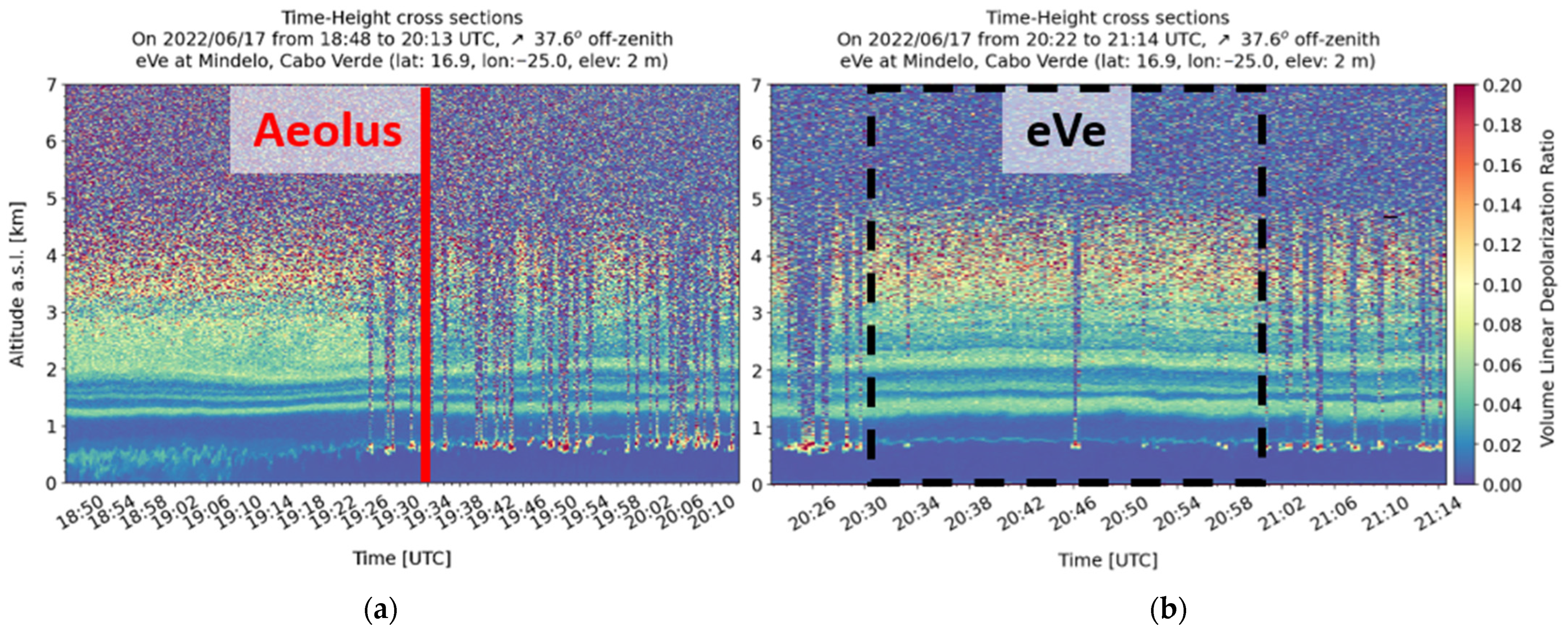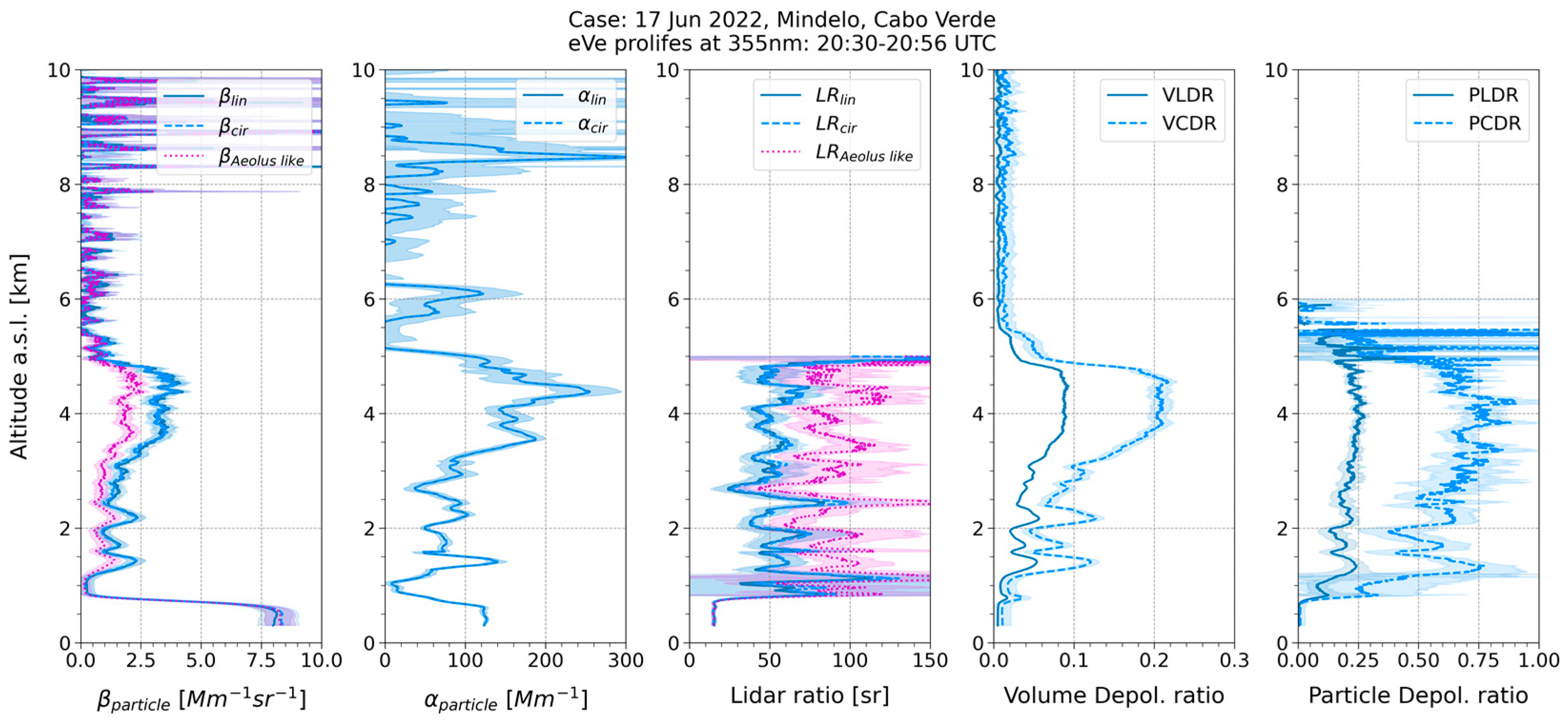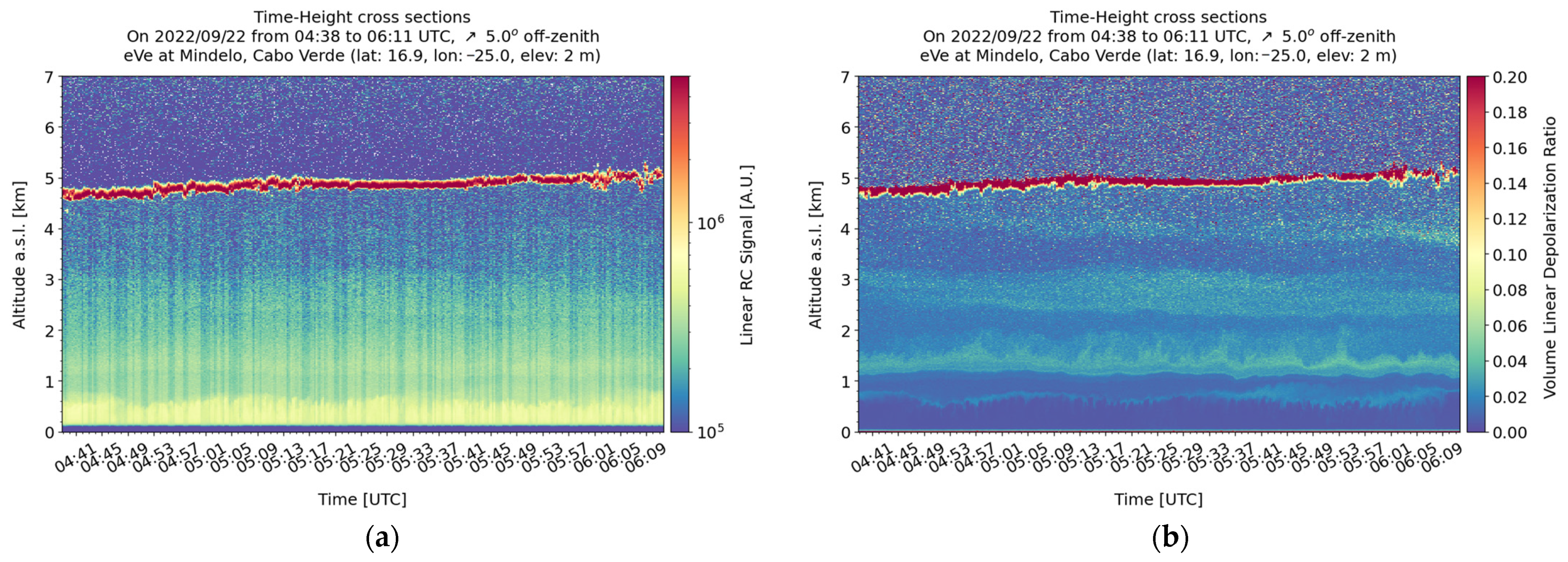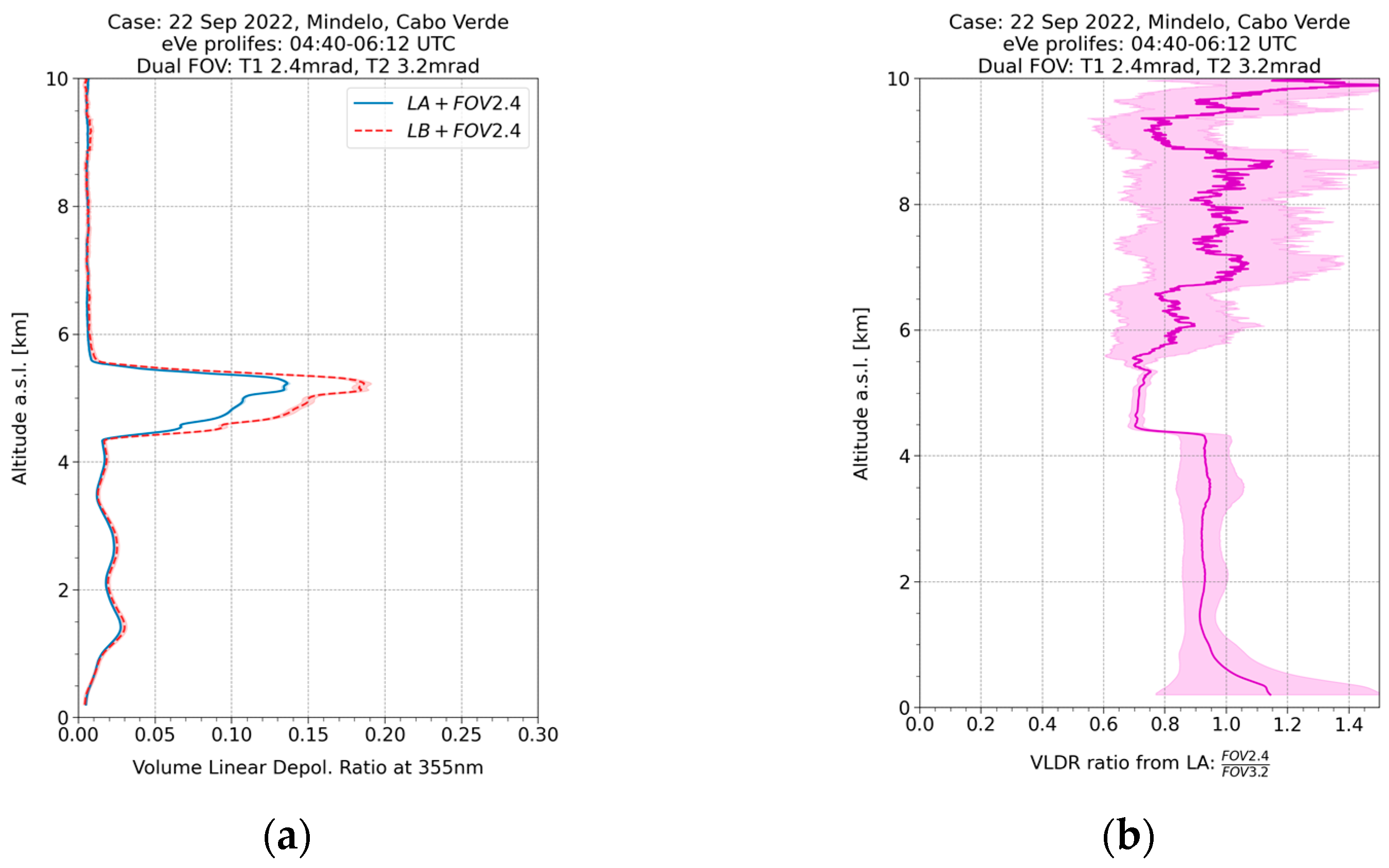eVe Lidar Measurements during the ASKOS/JATAC Campaign †
Abstract
:1. Introduction
2. Materials and Methods
2.1. The ASKOS Campaign
2.2. The eVe Lidar
3. Results
3.1. Linear and Circular Depolarization Measurements
3.2. Dual-Field-of-View Measurements
4. Discussion/Conclusions
Author Contributions
Funding
Institutional Review Board Statement
Informed Consent Statement
Data Availability Statement
Acknowledgments
Conflicts of Interest
References
- Stoffelen, A.; Pailleux, J.; Källén, E.; Vaughan, J.M.; Isaksen, L.; Flamant, P.; Wergen, W.; Andersson, E.; Schyberg, H.; Culoma, A.; et al. The atmospheric dynamics mission for global wind field measurement. Bull. Am. Meteorol. Soc. 2005, 86, 73–88. [Google Scholar] [CrossRef]
- Reitebuch, O. The Spaceborne Wind Lidar Mission ADM-Aeolus; Schumann, U., Ed.; Springer: Berlin/Heidelberg, Germany, 2012; pp. 815–827. [Google Scholar] [CrossRef]
- Tan, D.G.; Andersson, E.; Kloe, J.D.; Marseille, G.J.; Stoffelen, A.; Poli, P.; Denneulin, M.L.; Dabas, A.; Huber, D.; Reitebuch, O.; et al. The ADM-Aeolus wind retrieval algorithms. Tellus A Dyn. Meteorol. Oceanogr. 2008, 60, 191–205. [Google Scholar] [CrossRef]
- Flament, T.; Trapon, D.; Lacour, A.; Dabas, A.; Ehlers, F.; Huber, D. Aeolus L2A aerosol optical properties product: Standard correct algorithm and Mie correct algorithm. Atmos. Meas. Tech. 2021, 14, 7851–7871. [Google Scholar] [CrossRef]
- Fehr, T.; McCarthy, W.; Amiridis, V.; Baars, H.; von Bismarck, J.; Borne, M.; Chen, S.; Flamant, C.; Marenco, F.; Knipperz, P.; et al. The Joint Aeolus Tropical Atlantic Campaign 2021/2022 Overview–Atmospheric Science and Satellite Validation in the Tropics. In Proceedings of the EGU General Assembly 2023, Vienna, Austria, 24–28 April 2023. EGU23-7249. [Google Scholar] [CrossRef]
- Marinou, E.; Amiridis, V.; Paschou, P.; Tsikoudi, I.; Tsekeri, A.; Daskalopoulou, V.; Baars, H.; Floutsi, A.; Kouklaki, D.; Pirloaga, R.; et al. ASKOS Campaign 2021/2022: Overview of measurements and applications. In Proceedings of the EGU General Assembly 2023, Vienna, Austria, 24–28 April 2023. EGU23-16530. [Google Scholar] [CrossRef]
- Paschou, P.; Siomos, N.; Tsekeri, A.; Louridas, A.; Georgoussis, G.; Freudenthaler, V.; Binietoglou, I.; Tsaknakis, G.; Tavernarakis, A.; Evangelatos, C.; et al. The eVe reference polarisation lidar system for the calibration and validation of the Aeolus L2A product. Atmos. Meas. Tech. 2022, 15, 2299–2323. [Google Scholar] [CrossRef]
- Jimenez, C.; Ansmann, A.; Engelmann, R.; Donovan, D.; Malinka, A.; Seifert, P.; Wiesen, R.; Radenz, M.; Yin, Z.; Bühl, J.; et al. The dual-field-of-view polarization lidar technique: A new concept in monitoring aerosol effects in liquid-water clouds–Theoretical framework. Atmos. Chem. Phys. 2020, 20, 15247–15263. [Google Scholar] [CrossRef]
- Paschou, P.; Siomos, N.; Marinou, E.; Baars, H.; Gkikas, A.; Georgoussis, G.; Althausen, D.; Engelmann, R.; von Bismarck, J.; Fehr, T.; et al. First Results from the Aeolus reference lidar eVe during the tropical campaign JATAC at Cabo Verde. In Proceedings of the 30th International Laser Radar Conference, 26 June–1 July 2022. [Google Scholar]
- Haarig, M.; Ansmann, A.; Gasteiger, J.; Kandler, K.; Althausen, D.; Baars, H.; Radenz, M.; Farrell, D.A. Dry versus wet marine particle optical properties: RH dependence of depolarization ratio, backscatter, and extinction from multiwavelength lidar measurements during SALTRACE. Atmos. Chem. Phys. 2017, 17, 14199–14217. [Google Scholar] [CrossRef]
- Bissonnette, L.R.; Bruscaglioni, P.; Ismaelli, A.; Zaccanti, G.; Cohen, A.; Benayahu, Y.; Kleiman, M.; Egert, S.; Flesia, C.; Schwendimann, P.; et al. LIDAR multiple scattering from clouds. Appl. Phys. B Laser Opt. 1995, 60, 355–362. [Google Scholar] [CrossRef]
- Donovan, D.P.; Klein Baltink, H.; Henzing, J.S.; De Roode, S.R.; Siebesma, A.P. A depolarisation lidar-based method for the determination of liquid-cloud microphysical properties. Atmos. Meas. Tech. 2015, 8, 237–266. [Google Scholar] [CrossRef]
- Jimenez, C.; Ansmann, A.; Engelmann, R.; Donovan, D.; Malinka, A.; Seifert, P.; Wiesen, R.; Radenz, M.; Yin, Z.; Bühl, J.; et al. The dual-field-of-view polarization lidar technique: A new concept in monitoring aerosol effects in liquid-water clouds–case studies. Atmos. Chem. Phys. 2020, 20, 15265–15284. [Google Scholar] [CrossRef]




Disclaimer/Publisher’s Note: The statements, opinions and data contained in all publications are solely those of the individual author(s) and contributor(s) and not of MDPI and/or the editor(s). MDPI and/or the editor(s) disclaim responsibility for any injury to people or property resulting from any ideas, methods, instructions or products referred to in the content. |
© 2023 by the authors. Licensee MDPI, Basel, Switzerland. This article is an open access article distributed under the terms and conditions of the Creative Commons Attribution (CC BY) license (https://creativecommons.org/licenses/by/4.0/).
Share and Cite
Paschou, P.; Siomos, N.; Marinou, E.; Idrissa, S.M.; Quaye, D.T.; Attannon, D.D.F.; Meleti, C.; von Bismarck, J.; Fehr, T.; Amiridis, V. eVe Lidar Measurements during the ASKOS/JATAC Campaign. Environ. Sci. Proc. 2023, 26, 168. https://doi.org/10.3390/environsciproc2023026168
Paschou P, Siomos N, Marinou E, Idrissa SM, Quaye DT, Attannon DDF, Meleti C, von Bismarck J, Fehr T, Amiridis V. eVe Lidar Measurements during the ASKOS/JATAC Campaign. Environmental Sciences Proceedings. 2023; 26(1):168. https://doi.org/10.3390/environsciproc2023026168
Chicago/Turabian StylePaschou, Peristera, Nikolaos Siomos, Eleni Marinou, Samira Moussa Idrissa, Daniel Tetteh Quaye, Dêgbé Désiré Fiogbe Attannon, Charoula Meleti, Jonas von Bismarck, Thorsten Fehr, and Vassilis Amiridis. 2023. "eVe Lidar Measurements during the ASKOS/JATAC Campaign" Environmental Sciences Proceedings 26, no. 1: 168. https://doi.org/10.3390/environsciproc2023026168
APA StylePaschou, P., Siomos, N., Marinou, E., Idrissa, S. M., Quaye, D. T., Attannon, D. D. F., Meleti, C., von Bismarck, J., Fehr, T., & Amiridis, V. (2023). eVe Lidar Measurements during the ASKOS/JATAC Campaign. Environmental Sciences Proceedings, 26(1), 168. https://doi.org/10.3390/environsciproc2023026168





